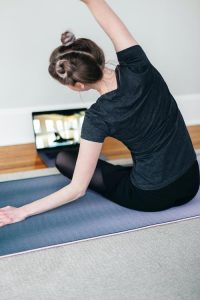 Q: [All Ages] My kids are both athletes and now they’re at home without team sports. How can we make good use of this time?
Q: [All Ages] My kids are both athletes and now they’re at home without team sports. How can we make good use of this time?
Now that essential social distancing/home isolation needs have replaced all the practices, games, rehearsals, performances, tournaments and competitions, what can young athletes do?
First of all, follow those social distancing and home isolation orders and ensure your families and friends follow them also. This isn’t the time for get-togethers, group hikes or in-person group practices. This is the time to protect the lives of vulnerable people and healthcare providers.
As a pediatric and sports medicine physician, many of the injuries I see are due to overuse and overload — too much activity, often amped up too fast or too soon for younger bodies. With many overload/overuse injuries, not only is it a volume thing that needs attention but often there are mechanical issues that need attention. For example, weakness in the central core areas (back of the shoulder and hip/lower back) can create poor function and pain in elbows, knees, legs and feet/ankles. These weakness patterns can be in part from rapid growth and also due to too much activity and built-up fatigue.
Some athletes need a break — time away from repetitive activity to heal these types of injury. The usual response I get when recommending rest centers around a variant of “I/we don’t have time to rest.”
Often, I’ll recommend rehabilitation exercise programs to address those issues. Even with the most diligent of athletes, it’s quite difficult to recover and get stronger/better while continuing to push through all the usual practices, games and competitions.
Now, these types of focused exercises and movement education aren’t just designed for the injured. Many teams, studios and institutions incorporate strength and conditioning exercises as part of regular training. Commonly, time is usually not an ally. Either athletes have limited (or no) time to get the full benefit, or they are trying to complete these programs while again pushing through practices, games, performances and competitions.
Well, in the midst of the overwhelming COVID-19 pandemic, now there is time for rest — for active recovery exercises, for trying something different.
- Maintain appropriate social distancing.
- Rest. This does not mean becoming a couch potato.
- If you are in a high volume/repetitive similar action activity (throwing, spiking, jumping, serving and leaping), take some time away. You may be shocked at how much better you feel with that relative rest.
- If you’re worried about losing conditioning, technique, timing and precision, realize that without coordinating with other teammates, close-up coaching and proper surfaces, it is hard to maintain high-level precision. Also realize that, unfortunately everyone else is at the same disadvantage, so take the best care of yourself.
- If you have connections to online programs, enjoy the benefits of social interaction with coaches/instructors/teammates. This is a key time for some of that general strength and conditioning work that we talked about earlier. Some sports medicine professionals are still available in offices and many have developed online exercise programs. Don’t be afraid to reach out and use this time to your best advantage, but make sure you are getting sensible advice.
- Please do use common sense when exercising at home. For example, trying to do repetitive leaps and jump combinations on the kitchen tile floor may put unnecessary stress on your legs. I have also talked with coaches and instructors who are cautious about assigning exercise programs — they worry about risk of injury due to lack of supervision.
- I’m going to challenge you to look at things differently, especially if you see yourself as a single-activity athlete. Let’s make a goal of not just trying to be a better player, but rather look for ways to become a better overall athlete. Can you jump more efficiently (without knees caving inward)? Can you work on making the muscles behind your shoulders more effective? Here’s the chance to work on those injury rehab/reduction or general strength programs.
- Speaking of looking at things differently, here’s my second and somewhat linked challenge — find something totally new (or something you haven’t done in a long time) and just do it! Go on a hike (social distance alert again), play board games or write in a journal. Do something that you haven’t had time to do until now. Go out and do some free play. Let kids direct what’s going on and have less adult organization and outcomes.
- Get those eight to nine hours of sleep. This is always vital and especially now in stressful times. Try to keep a good schedule with regular bedtime and awakenings. Before going to bed, write down two to three things that went well during the day and you are grateful for. These positive habits of gratitude can help with feelings of lack of control that many are experiencing at this time.
At some point, your child will be able to return to their sport — more rested, healthy and hopefully injury-free. On the flip side, some young athletes might realize that after time away and doing other things, they don’t miss their past activities at all. Both scenarios are quite likely and should be considered “OK.” Your young athlete should be given full permission and the opportunity to make decisions about future sport/activity choice, level of play and time commitment.
 Dr. Chris Koutures is a dual board-certified pediatric and sports medicine specialist who practices at ActiveKidMD in Anaheim Hills. He is a team physician for USA Volleyball (including participating in the 2008 Beijing Olympics), the U.S. Figure Skating Sports Medicine Network, Cal State Fullerton Intercollegiate Athletics, Chapman University Dance Department and Orange Lutheran High School. He offers a comprehensive blend of general pediatric and sport medicine care with an individualized approach to each patient and family. Please visit activekidmd.com or follow him on Twitter (@dockoutures).
Dr. Chris Koutures is a dual board-certified pediatric and sports medicine specialist who practices at ActiveKidMD in Anaheim Hills. He is a team physician for USA Volleyball (including participating in the 2008 Beijing Olympics), the U.S. Figure Skating Sports Medicine Network, Cal State Fullerton Intercollegiate Athletics, Chapman University Dance Department and Orange Lutheran High School. He offers a comprehensive blend of general pediatric and sport medicine care with an individualized approach to each patient and family. Please visit activekidmd.com or follow him on Twitter (@dockoutures).
Photo Credit: Kari Shea






Leave a Reply